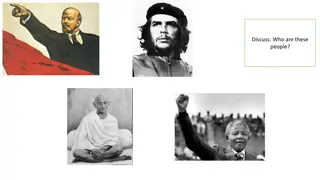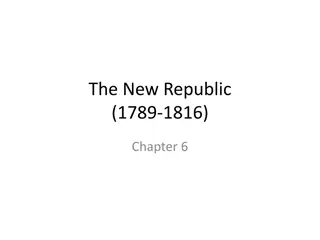George Washington: An American Revolutionary
George Washington, the first President of the United States, had a wealthy upbringing in Virginia, where he owned slaves and later became one of the richest men. He played a pivotal role in the Continental Army during the American Revolution, facing challenges against the well-equipped British forces. Despite the odds, Washington's leadership and determination helped secure American independence.
Download Presentation

Please find below an Image/Link to download the presentation.
The content on the website is provided AS IS for your information and personal use only. It may not be sold, licensed, or shared on other websites without obtaining consent from the author.If you encounter any issues during the download, it is possible that the publisher has removed the file from their server.
You are allowed to download the files provided on this website for personal or commercial use, subject to the condition that they are used lawfully. All files are the property of their respective owners.
The content on the website is provided AS IS for your information and personal use only. It may not be sold, licensed, or shared on other websites without obtaining consent from the author.
E N D
Presentation Transcript
LO: 3.3 ONLINE RESOURCES Chapter 12 (12.3) An American Revolutionary: George Washington
A LIFE IN TIME: GEORGE WASHINGTON (1732 1799) George Washington was the first president of the United States of America.
EARLY LIFE George Washington was born in the colony of Virginia to a family of wealthy landowners. They farmed tobacco and owned a number of African slaves. He fought in the British army in the Seven Years War. Afterwards, he was elected to Virginia s assembly.
EARLY LIFE MARRIAGE He inherited the family estates and in 1759 he married Martha Dandridge Custis, a wealthy widow, becoming one of the richest men in Virginia.
THE CONTINENTAL ARMY Washington was elected to represent Virginia at the First and Second Continental Congresses. He supported independence once he realised that there could be no compromise between the colonies and Britain. He was appointed commander-in-chief of the Continental Army in 1775.
THE CONTINENTAL ARMY He received this position due to his military experience and because, as a Virginian, his appointment guaranteed the support of the largest and richest colony. Washington faced a daunting situation, as the following comparison of the armies shows.
The Continental Army 20,000 men Part-time soldiers, many only serving for short periods Poorly trained and equipped: a variety of guns and other weapons, even makeshift ones from farm tools Problems of indiscipline and disease Congress was slow to pay the army The soldiers had local knowledge and could use this against the British
The British Army 80,000 men Professional, full-time soldiers Well trained and equipped with the best weapons of the time Large navy for supplies Fighting in an unfamiliar country Treated all Americans as enemies and punished civilians, increasing support for the rebels Thousands of miles from home
THE WAR OF INDEPENDENCE After fighting broke out in 1775, there were a number of major battles between the two sides: Washington lost his first battle, at Bunker Hill, but inflicted heavy casualties on the British. The Continental Army won the Battle of Boston and captured cannons and rifles which were needed for the war.
THE WAR OF INDEPENDENCE After Washington was defeated at New York in 1776, he gained two small victories at Princeton and Trenton. In 1777, the British General Howe s army of 18,000 men captured Philadelphia, America s largest city and the home of the Continental Congress. This was a huge blow: many people began to doubt that America could win and they questioned Washington s leadership.
TURNING POINT: SARATOGA AND THE ENTRY OF THE FRENCH The month after the loss of Philadelphia, the American General Gates defeated a British army of 8,000 men at Saratoga. This victory reassured the American people and some of Britain s European rivals became interested. France, Spain and the Netherlands joined the war against Britain in 1778.
TURNING POINT: SARATOGA AND THE ENTRY OF THE FRENCH French help was particularly key to the colonies eventual victory. They sent 6,000 troops and weapons and used their fleet to disrupt British supplies. In addition, more troops had to stay behind in Britain in case of a French attack there.
TURNING POINT: VALLEY FORGE After his defeat at Philadelphia, Washington regrouped at a remote base called Valley Forge with his 11,000 men during the winter of 1777 1778. This was one of the harshest winters of the century. The men endured great hardship and hunger in the freezing cold. Disease was rife in the camp and by the end of February, 3,000 men had died and hundreds more had deserted (abandoned the army).
TURNING POINT: VALLEY FORGE However, the army that emerged from Valley Forge at winter s end had been transformed. Washington had won the undying loyalty of his men by refusing to abandon them and sharing in their terrible conditions. During the winter, the professional Prussian soldier Baron Von Steuben had drilled the soldiers until they were as well trained and disciplined as any European army.
VICTORY AT YORKTOWN Over the next few years, the balance of the war turned in favour of the Americans. They won more battles, and Washington kept the British largely confined to New York. ` The British surrender at Yorktown
VICTORY AT YORKTOWN In the decisive battle at Yorktown in October 1781, 7,000 British soldiers under Lord Cornwallis were surrounded by 9,000 American and 5,000 French troops on land and a French fleet at sea. Cut off from reinforcements and supplies and outnumbered two to one, Cornwallis surrendered to Washington.
VICTORY AT YORKTOWN This marked the end of the war. The Treaty of Paris was signed between the former colonies and the British in 1783.
WASHINGTONS LATER LIFE After the victory in the war, Washington retired to his Mount Vernon estate. He was soon called back to serve the people as the president of the Constitutional Convention. This was called in 1787 to write a constitution for their new country, the United States of America.
WASHINGTONS LATER LIFE A CONSTITUTION is the set of fundamental rules for running a country that outlines the powers of government and the rights of citizens. The American constitution established a FEDERAL REPUBLIC, a system of government where power is divided between a central government (usually headed by a president) and various regions or states.
WASHINGTONS LATER LIFE Washington was elected the first president of the US in 1789 and was re-elected in 1792. He worked to set up the new American government and surrounded himself with the best men of his age to work with him, including Thomas Jefferson, Alexander Hamilton and John Adams. He retired to Mount Vernon, where in 1799 he died from pneumonia.
WASHINGTONS LATER LIFE The capital of the US was named Washington in honour of the man many Americans consider the father of the nation . ` The Washington Monument
A federal republic is a system of government where power is divided between a central government (usually headed by a president) and various regions or states.
A constitution is the set of fundamental rules for running a country that outlines the powers of government and the rights of citizens.
REVIEW QUESTIONS How did Washington become one of the wealthiest men in Virginia? Washington inherited his brother s land and married a very wealthy widow.
REVIEW QUESTIONS Why was he selected to command the Continental Army? Due to his military experience, and because his appointment guaranteed the support of the largest and richest colony, Virginia.
REVIEW QUESTIONS What advantages and disadvantages did the Continental Army have at the start of the war? Advantages of the Continental Army: Local knowledge; guerrilla warfare. Disadvantages: Far smaller (only 20,000 men), part-time only, lacked discipline, poorly equipped, poorly trained.
REVIEW QUESTIONS What advantages and disadvantages did the British army have at the start of the war? Advantages of the British Army: Larger (80,000 men); professionally trained and equipped; well financed and supplied by the British fleet. Disadvantages: Thousands of miles from home; lost the support of the people by treating them all as enemies.
REVIEW QUESTIONS Why was the victory at Saratoga so important to the Americans? Victory at Saratoga restored confidence after the defeat at Philadelphia and convinced other countries, such as France, to enter the war on the American side.
REVIEW QUESTIONS What happened at Valley Forge? Washington spent the harsh winter of 1777 1778 at Valley Forge training his army and turning them into a modern, professional army.
REVIEW QUESTIONS Give three reasons why the Americans won the war. Supported by the colonists; guerrilla tactics wore down the British; they had French support; Washington s leadership; training at Valley Forge; victory at Yorktown.
REVIEW QUESTIONS What did Washington do after the war to serve America? He chaired the Constitutional Convention and served as the first president.
REVIEW QUESTIONS What is a constitution? A constitution is the set of fundamental rules for running a country that outlines the powers of government and the rights of citizens.
ONLINE RESOURCES (Please note you will need to be online to access these resources) The History Channel : https://educateplus.ie/go/history-george- washington https://educateplus.ie/go/george-washington Online exhibition at the Museum of the American Revolution: https://educateplus.ie/go/amrev























